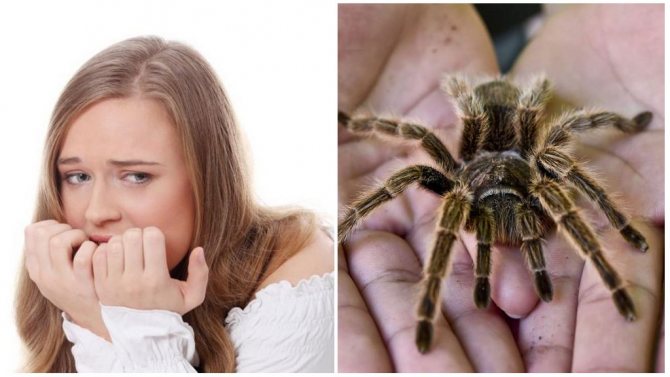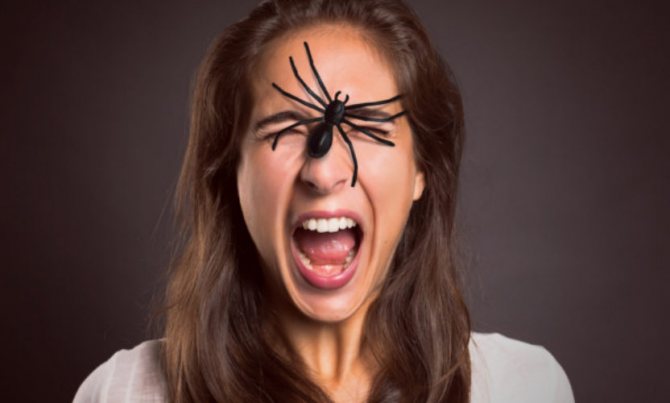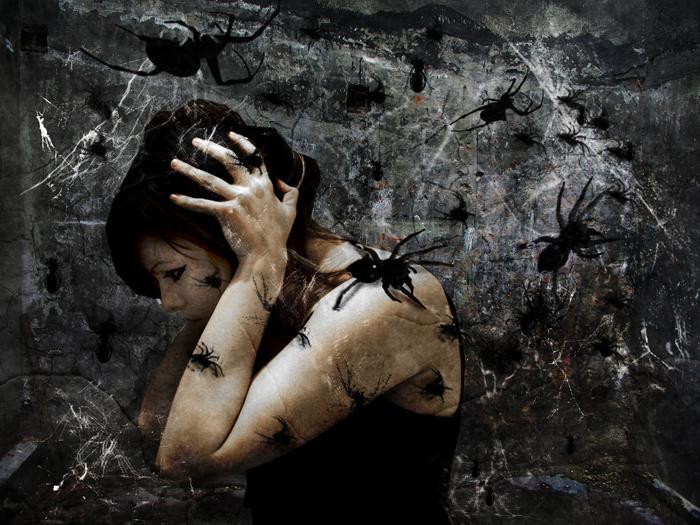Arachnophobia - fear of spiders and arachnids is one of the ten most "popular" phobias. The term itself comes from words from the Greek language: ἀράχνη - spider, ἀράχνη - horror. Arachnophobia is a special case of zoophobia, a broad category of anxiety disorders that affects any species of animals. According to research by American psychologists, up to 50% of the female population of the United States is afraid of snakes, while the male population is susceptible to this phobia only by 10%. At the same time, the fear of spiders does not differ by gender, and the percentage of those susceptible to fear of arachnids significantly exceeds the fear of dogs and snakes.
Arachnophobia is a pathological, uncontrollable, progressive over time fear of spiders and any arachnids - scorpions, haymakers and others.
Patients susceptible to arachnophobia experience a feeling of fear or severe panic not only when they come into contact with the phobic object (visual, tactile), but also when they mention it: they can be frightened by stories about arachnids, watching TV about these animals, as well as the sight of deceased arachnids, their web , photos with their image. It is enough just to hint to such a person that a spider has appeared in the room in order for him to have an attack of hysteria. Patients begin to scream in panic, climb onto chairs and other heights, strive to leave the room - their fear is so strong.
What is the danger of arachnophobia
Arachnophobia is a condition that poses a potential danger to the body, in particular to its psychological state.
Regular obsessive thoughts and neuroses are manifested:
- insomnia due to the belief that a spider can get into the ear and lay eggs there;
- panic fear of contact with arachnids, confidence in the high probability of infection from an arthropod.
The result of such conditions is the formation of negative strains of behavioral motivation, long-term fixation on the object. That is, a person suffering from arachnophobia begins to purposefully search for spiders even where they objectively cannot be. In especially severe forms, hallucinations and other forms of changes in consciousness appear. A person can see and even tactilely feel the presence of spiders, and, under the influence of a panic attack, unconsciously injure himself and others.
That is why it is important that when signs of unnatural fear appear, it is important to take timely measures to treat the disease.
Are spiders really that scary?
Spiders, especially in our country, are absolutely harmless creatures. Even if we are talking about poisonous representatives, then they never show aggression first, that is, they do not attack, but, on the contrary, defend themselves. And it's not so easy to meet a poisonous spider, because almost all of them are listed in the Red Book. These include:
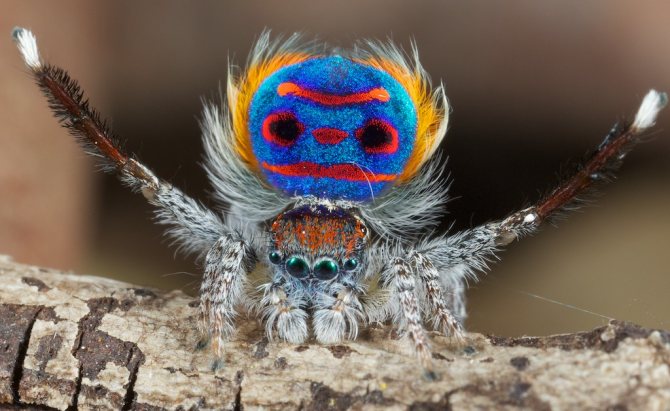
- Karakurt;
- Eresus;
- South Russian tarantula;
- Spider-cross;
- Silver water spider.
They pose a danger to life and health, but only in those cases if you do not know some of the details about them.
If we talk about karakurt, then only females, which are several times larger than males, are dangerous.Tarantula bites are not very pleasant, which can cause an allergic reaction, and a rather painful swelling forms at the site of the bite. True, it is quite easy to reduce the likelihood of negative consequences - it is enough to cauterize the bite with a match. Eresus bites are not very pleasant, but they do not pose a danger to either life or health, the discomfort at the site of the bite disappears after 2-6 days. The same can be said about the bites of the cross and dropsy - they are painful, but not dangerous.
From all of the above, we can conclude that some types of spiders actually pose a danger to human health, but in most cases their bites cause temporary inconvenience.
The number of truly dangerous species is not very large, therefore, not every person can face them in ordinary life. It should also be remembered that a spider, even the most poisonous, does not attack first, so when you meet him you must behave calmly, not forcing him to defend himself.
This is also interesting: We get rid of spiders in the country and the garden with our own hands
Arachnophobia: causes of occurrence
Psychiatric doctor Mary Cover Jones has conducted research that has shown that arachnophobes actually know the cause of their phobia, and the fear of spiders is no exception.
There are several common reasons why a phobia occurs:
- Personal experience from childhood. A psychological study carried out by Dutch scientists more than 50 years ago has shown that 46% of children are afraid of spiders and similar insects. Of these, 41% noted that the reason for the traumatic fear was a collision with them.
- Genetic predisposition. Fear of spiders is a genetic instinct for self-preservation.
- A feature of the nervous system. Individuals with a weak type of nervous system (choleric, melancholic) are more prone to phobias, according to the data of the American Psychiatric Association.
- Improper teaching in childhood. Children always perceive the parental model of behavior as a standard for inheritance. If the mother or father suffers from arachnophobia, anxiety is transmitted to the child. Anxiety-phobic disorder is fixed in consciousness and often haunts a person throughout his life.
- Suddenness. The role of surprise, when a person suddenly sees a spider in front of him, often becomes the impetus for the emergence of a phobia. In this case, the rapid, unpredictable movements of the insect become a cause for alarm.
- A special model of behavior. There is speculation that phobic personality disorder is inherent in regions with a large population of arachnids.
What is the name of the fear of spiders, and what symptoms accompany it


Spider phobia - arachnophobia manifests itself in several cases, in the presence of a stress catalyst and its absence. In the latter case, fear manifests itself in the form of increased anxiety and readiness to meet with a spider at any time. At the physical level, there are no changes, only a feeling of "goose bumps" appears on the body.
Upon contact with the object of fear, a spectrum of the following physiological changes is observed:
- uneven pulse, heart palpitations;
- increased sweating;
- cold extremities;
- small tremors;
- nausea;
- numbness.
In especially severe forms of fear, the general condition is complicated by the following symptoms: dilated pupils, difficulty breathing, involuntary muscle relaxation below the waist. It follows from this that fear of spiders is a condition that significantly impairs the quality of life. It requires complex treatment: psychotherapy and the use of pharmacological agents.
Arachnophobia what is this disease: the main symptoms
Symptoms accompanying arachnophobia are divided into momentary and delayed.
Momentary include:
- state of "stupor";
- desire to run away;
- fixation on the object of fear;
- narrowing of consciousness up to its loss;
- partial memory loss.
Delayed symptoms of fear of spiders imply some kind of compulsion. Man seeks to turn his home into an impregnable bastion for spiders, even if they do not exist there. A phobic person cleans rooms too often, seals up cracks or refuses to open windows. He is characterized by excessive aggressiveness and irritation.
Many people who know what the fear of spiders is called and what its symptoms are, do not know what the extreme form of this condition can lead to. Increased anxiety and extreme fear are painfully experienced by the patient. Although panic attacks are usually a response to the appearance of a stress spider, over time they take on a wave-like character and make themselves felt several times a month.
In addition to fear, a person has:
- painful sensation in the chest area;
- feeling of your own heart;
- violation and difficulty of thought processes;
- numbness and tingling in the hands and feet;
- deterioration in sleep;
- abdominal pain, gastrointestinal disturbances;
- unsteadiness of gait.
Recommendations
Remember that any phobia puts you in a box. To be led by your fears is to be their slave. Fears are treated with the opposite behavior. You can choose a softer method and make an appointment with a psychotherapist. You can cope with fear on your own by showing will. Force yourself to pick up the spider.


Author of articles. I understand phobias, complexes, psychological trauma.
On the dangers of self-medication for arachnophobia
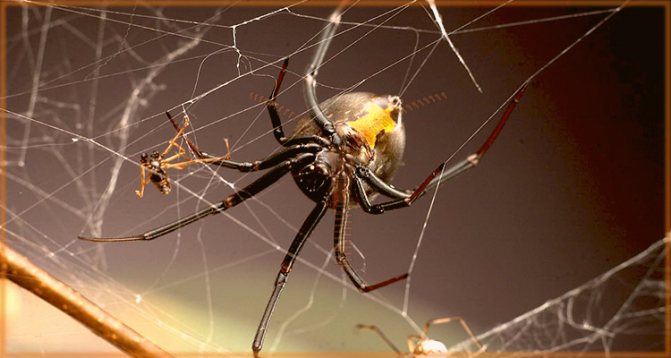

A common mistake of those who are faced with obsessive fears is trying to solve their problem on their own.
When panic attacks appear, doctors categorically do not recommend purchasing and using drugs that have a sedative effect.
- It will not have a calming effect without regular sessions of individual psychocorrection.
- Preparations are selected individually, taking into account the characteristics of a person's condition. Before starting treatment, it is important to make sure that the disease really occurs. The diagnosis can only be made by a psychoanalyst based on a patient interview. The fact is that they often confuse a real phobia and aversion to arachnids. The main symptom that distinguishes these signs from each other is the presence of panic attacks that occur with one type of spider.
Drug therapy
To combat the pathological fear of spiders, several groups of medicines are used:


Behavioral psychology as an effective treatment for arachnophobia
Fear of spiders is a phobia that can be easily eliminated by constantly bringing the patient closer to the object of his fear. In this case, therapy should be carried out only under the supervision of a specialist, otherwise there is a risk of worsening the condition. If a panic attack occurs, the procedure should be stopped immediately.Treatment of arachnophobia with this method is constantly worth it, starting with the demonstration of photos and videos of spiders. Further, in the absence of side effects, you can begin to approach the real object of fear.
If you turn to a psychotherapist with the question of how to get rid of arachnophobia, you will receive an answer about the need to use methods of behavioral (behavioral) therapy. Its effectiveness has been proven by the fact that many arachnophobes, after successful psychocorrection, give birth to exotic spiders as pets. In psychology, this is called hypercompensation of fears (the patient not only got rid of the phobia, but also dominates it).
Medicinal treatments for fear of spiders
Many arachnophobes, who do not often face the object of their fear, rarely turn to qualified psychiatrists or psychotherapists. Since the chances of facing fear face to face increase in nature, arachnophobes limit themselves from staying in forests, squares, parks and other places where spiders can live.
If the disease is too strong, and panic attacks interfere with a full life, you cannot do without the help of a psychotherapist. He selects an acceptable method of treatment depending on the cause of the phobia, its nature and the individual characteristics of the client.
The pathological fear of spiders is a phenomenon in which medications cannot be dispensed with. The use of pharmacological drugs (antidepressants, nootropics, tranquilizers and vitamin complexes) gives good results and contributes to:
● stopping panic attacks; ● reducing the level of anxiety; ● increasing the body's resistance to stress.
The uncontrolled use of certain substances can have the opposite effect. It is important to follow the prescriptions of the doctor who selects the dosage and treatment regimen.
Also, use some simple tips to help you overcome simple forms of arachnophobia:
- reach out to someone who is not afraid of spiders and interacts with them calmly. Looking at a person who communicates with a spider without fear, it is much easier to overcome your fear;
- try to get close to the spider, this is called "exposure therapy";
- be aware of your feelings and speak them out loud. A detailed description of your own fears helps to cope with them.
Psychotherapy for arachnophobia
Fear of spiders is a disease that requires an integrated approach. Along with taking medications, it is important to resort to psychotherapy. It starts with a conversation with a patient. During the diagnosis, the therapist determines the source of the fear. This is possible even in the case when the client himself does not remember the factor that became the stimulus for the onset of arachnophobia, or is not aware of it.
Qualified support and correct diagnostics help to form a new model of behavior when interacting with insects. Following the recommendations, an arachnophobe will be able to suppress panic attacks, get rid of obsessive thoughts and even respond adequately to a meeting with an object of fear.
The most effective methods of psychotherapy are considered:
- situational therapy. It is preparing the client to deal with what triggers the anxiety attacks. The psychotherapist gives as much information as possible about arachnids and why they are harmless. At the end of the conversation, a short meeting with a spider (real or its image) is possible. Further, the duration of contact with the insect gradually increases;
- cognitive behavioral therapy. The key action of the method is to stimulate the client to change his own idea of spiders. It is aimed at the client's rational rethinking of the object of fear and changing the attitude towards it;
- hypnosis. This controversial technique has been shown to be effective in a number of cases.The fear of spiders is eliminated on an individual basis, depending on the intensity of the disorder.
Some fun facts about arachnophobia:
- People living in countries where spiders are eaten are not at all susceptible to spider phobias. As numerous studies show, in Asia and some African countries, even the thought of the very fact of a poisonous spider bite does not cause fear.
- To individuals with arachnophobia, spiders seem much larger than they really are. In one study, recipients were asked to look at spiders and estimate their size. The greater the fear of the spider in man, the more he exaggerated the size of the arthropod.
- In developed countries today, the number of people suffering from acute forms of arachnophobia is significantly decreasing. Oddly enough, psychologists attribute this to the popularization of the Spider-Man comic book character. In the minds of children, a model is formed, according to which contact with an arthropod is not only safe, but also useful.
Any negative experience poses a threat to mental and even physical health. Don't wait for your fears to escalate into severe frustration and poison your life! The main thing is not to suppress your fears and be honest with yourself - this way you will be able to say goodbye to obsessive thoughts once and for all!
Symptoms
Very often, people far from psychology confuse arachnophobia with the usual disgust and natural disgust that arthropods can cause.
True arachnophobia has a number of specific features. In particular, it develops over many years, almost never arising spontaneously. The main problem for people with anxiety about spiders is that the fear can arise at any time. Sometimes, for the appearance of negative emotions, one mention of a frightening irritant in a conversation is enough.
A panic attack develops, which can be dangerous for a person who, under the influence of terror, loses the ability to control his own behavior.
The attack is accompanied by a disruption in the functioning of the autonomic nervous system, as a result of which a heart attack or heart attack may occur. In addition, arachnophobia worsens the quality of life, because a person is afraid to go where there may be spiders.
He cannot go down to the basement or go for a walk in the forest or park.
The main symptoms of arachnophobia are as follows:
- panic attack, which a person is not able to prevent by volitional efforts;
- lethargy or overexcitation (a person either falls into a stupor or tries to escape, not taking into account the environment and the appropriateness of his behavior);
- pallor of the skin;
- increased heart rate;
- the appearance of cold sweats;
- the emergence of a feeling that everything that happens is unreal;
- chaotic attempts to kill the spider.
If a person tries in every possible way to kill an insect that accidentally came into his field of vision, we can talk about the initial symptoms of arachnophobia.
Sometimes the next step is the intention to find and destroy the spider nest in your own home or in the surrounding area. Women suffering from arachnophobia often spend a lot of time trying to clean up their apartment.
If you closely follow the behavior of a person with arachnophobia, it becomes obvious that his actions are in the nature of learned ones. This is not surprising, because the disease begins to form at an early age, when the child tried to copy the behavior of loved ones that are significant to him.










